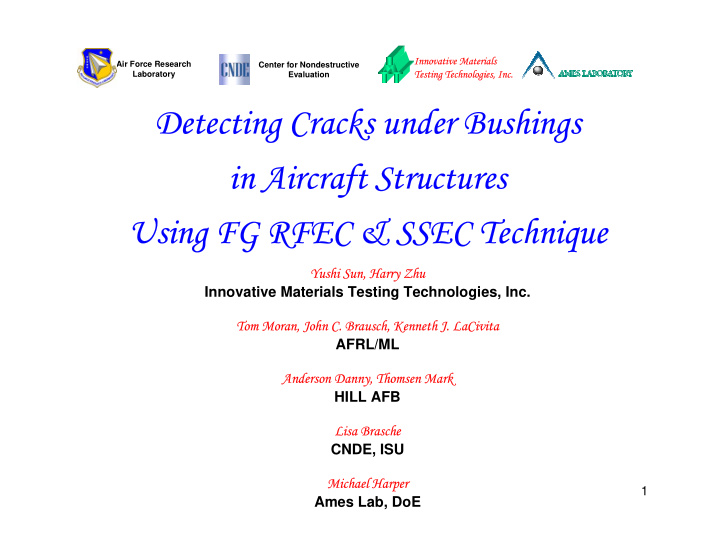



Inno Innovative Materials tive Materials Air Force Research Center for Nondestructive Testin Testing T Tech chnologies, es, I Inc. c. Laboratory Evaluation Detecting Cracks under Bushings Detecting Cracks under Bushings in Aircraft Structures in Aircraft Structures Using FG RFEC & SSEC Technique Using FG RFEC & SSEC Technique Yushi Sun, Harry Zhu Yushi Sun, Harry Zh Innovative Materials Testing Technologies, Inc. Tom Mora Tom Moran, John C. Brau n, John C. Brausch, Ke sch, Kenne nneth J. LaC th J. LaCivita vita AFRL/ML Anderson Danny, Th Anderson Danny, Thomsen Mark omsen Mark HILL AFB Lisa Brasche Lisa Brasche CNDE, ISU Michael Harper Michael Harper 1 Ames Lab, DoE
Inno Innovative Materials tive Materials Air Force Research Center for Nondestructive Testin Testing T Tech chnologies, es, I Inc. c. Laboratory Evaluation 1. A challenge to detect cracks in cross- bolt holes when the cracks are located beneath repair bushings. 2.Removal of a bushing is costly and may bring new damage to the holes. 3.There has been a demand for techniques that is capable of detecting cracks in cross-bolt holes through a bushing. 2
Inno Innovative Materials tive Materials Air Force Research Center for Nondestructive Testin Testing T Tech chnologies, es, I Inc. c. Laboratory Evaluation Target Aircraft Component: Wing Attach Fitting Inspection through bushing. Holes 1, 2 Holes 3, 4 AFT Holes 1, 2 Holes 3, 4 FWD Holes 1 & 2: 7 Layers Holes 3 & 4: 5 Layers 3
Inno Innovative Materials tive Materials Air Force Research Center for Nondestructive Testin Testing T Tech chnologies, es, I Inc. c. Laboratory Evaluation Test Standard Φ 0.50” Fastener Holes 0.320” 4340 C(A) 0.094” SHIM d E 0.300” 2024-T3511 F(H) 0.344” 2024-T3511 100” × 100” EDM #2 50” × 50” EDM #1 INCONEL 718 Bushings 4
Inno Innovative Materials tive Materials Air Force Research Center for Nondestructive Testin Testing T Tech chnologies, es, I Inc. c. Laboratory Evaluation Probe Developed: RF BSH0.5 Test Frequency: 10 kHz - 80 kHz Connectors Slip Ring Part for Z-Position Rotation Guide with ball-bearing Rotation Handle Permanent Magnet Probe Holder Probe head Z Drive Coil Pickup Coil 0 270 90 180 360 Unwrapped surface of probe head [ º ] 5
Innovative Materials Inno tive Materials Air Force Research Center for Nondestructive Testin Testing T Tech chnologies, es, I Inc. c. Laboratory Evaluation SSEC Settings – A Screen Copy Simulated Reflection Differential Mode with step = 5 points Digital LPF, cutoff frequency = 1.0 Hz 6
Inno Innovative Materials tive Materials Air Force Research Center for Nondestructive Testin Testing T Tech chnologies, es, I Inc. c. Laboratory Evaluation Probe Position 1 Z = 0.885” Imaginary, Y [25 mv per grid] Real, X Steel EDM #1 Z EDM #2 Coil Imaginary, Y EDM #1: 50” × 50” EDM #2: 100” × 100” Sample Points Real, X [25 mv per grid] Data Buffer 7
Innovative Materials Inno tive Materials Air Force Research Center for Nondestructive Testin Testing T Tech chnologies, es, I Inc. c. Laboratory Evaluation Position 2 Z = 0.715” EDM #2 can be detected from Z=0.685” to Z=0.760” Imaginary, Y [25 mv per grid] Real, X Steel EDM #1 Z EDM #2 Imaginary, Y Coil EDM #1: 50” × 50” EDM #2: 100” × 100” Sample Points Real, X [25 mv per grid] Data Buffer 8
Inno Innovative Materials tive Materials Air Force Research Center for Nondestructive Testin Testing T Tech chnologies, es, I Inc. c. Laboratory Evaluation Probe Position 1 Z = 0.565” Imaginary, Y [25 mv per grid] Real, X Steel EDM #1 Z Imaginary, Y Coil EDM #2 EDM #1: 50” × 50” EDM #2: 100” × 100” Sample Points Real, X [25 mv per grid] Data Buffer 9
Innovative Materials Inno tive Materials Air Force Research Center for Nondestructive Testin Testing T Tech chnologies, es, I Inc. c. Laboratory Evaluation Position 2 Z = 0.395” EDM #1 can be detected from Z=0.395” to Z=0.415” Imaginary, Y [25 mv per grid] Real, X Steel Coil Z EDM #1 Imaginary, Y EDM #2 EDM #1: 50” × 50” EDM #2: 100” × 100” Sample Points Real, X [25 mv per grid] Data Buffer 10
Inno Innovative Materials tive Materials Air Force Research Center for Nondestructive Testin Testing T Tech chnologies, es, I Inc. c. Laboratory Evaluation Conclusions 1. The two EDM Notches made on layer E are detected with high S/N ratios. 2. The permanent magnet probe holder and the ball-bearing rotation guide help with noise reduction and ease of operation. 3. Comparing the signal responses of the two notches the 0.100” × 0.100” EDM Notch, Notch #2, can be detected in a large range of probe position Z, see Page 8. 4. The 4340 steel layer enhances the signal response from the 0.050 ” × 0.050” EDM notch, Notch #1. However, it moves the location for optimal detection towards steel side, see Page 10. 11
Inno Innovative Materials tive Materials Air Force Research Center for Nondestructive Testin Testing T Tech chnologies, es, I Inc. c. Laboratory Evaluation Future Work 1. Motorize probe rotation 2. Automatic C-Scan and Real-Time Imaging 3. Consider thickness variation of bushing 4. Try detection of bore-hole crack with and without an installed bushing. 5. Commercialization 6. Field testing and POD study 12
Recommend
More recommend